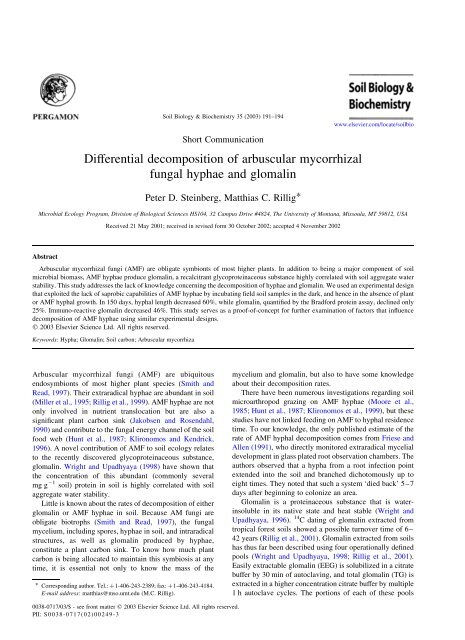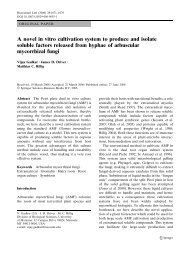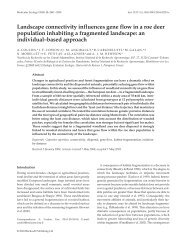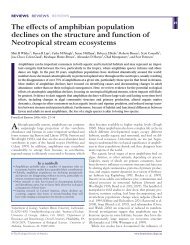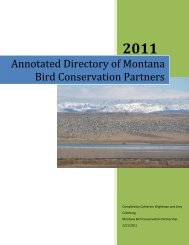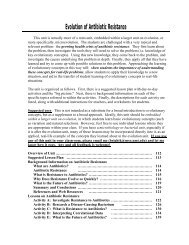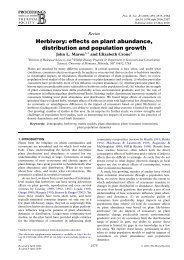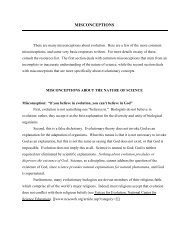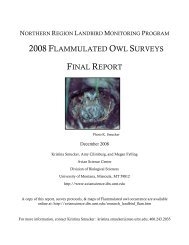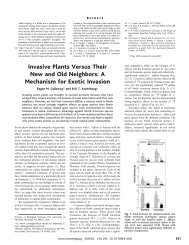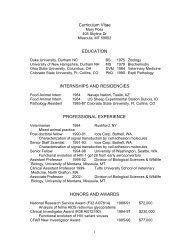Differential decomposition of arbuscular mycorrhizal fungal hyphae ...
Differential decomposition of arbuscular mycorrhizal fungal hyphae ...
Differential decomposition of arbuscular mycorrhizal fungal hyphae ...
Create successful ePaper yourself
Turn your PDF publications into a flip-book with our unique Google optimized e-Paper software.
Soil Biology & Biochemistry 35 (2003) 191–194<br />
Short Communication<br />
<strong>Differential</strong> <strong>decomposition</strong> <strong>of</strong> <strong>arbuscular</strong> <strong>mycorrhizal</strong><br />
<strong>fungal</strong> <strong>hyphae</strong> and glomalin<br />
Peter D. Steinberg, Matthias C. Rillig*<br />
Microbial Ecology Program, Division <strong>of</strong> Biological Sciences HS104, 32 Campus Drive #4824, The University <strong>of</strong> Montana, Missoula, MT 59812, USA<br />
Received 21 May 2001; received in revised form 30 October 2002; accepted 4 November 2002<br />
www.elsevier.com/locate/soilbio<br />
Abstract<br />
Arbuscular <strong>mycorrhizal</strong> fungi (AMF) are obligate symbionts <strong>of</strong> most higher plants. In addition to being a major component <strong>of</strong> soil<br />
microbial biomass, AMF <strong>hyphae</strong> produce glomalin, a recalcitrant glycoproteinaceous substance highly correlated with soil aggregate water<br />
stability. This study addresses the lack <strong>of</strong> knowledge concerning the <strong>decomposition</strong> <strong>of</strong> <strong>hyphae</strong> and glomalin. We used an experimental design<br />
that exploited the lack <strong>of</strong> saprobic capabilities <strong>of</strong> AMF <strong>hyphae</strong> by incubating field soil samples in the dark, and hence in the absence <strong>of</strong> plant<br />
or AMF hyphal growth. In 150 days, hyphal length decreased 60%, while glomalin, quantified by the Bradford protein assay, declined only<br />
25%. Immuno-reactive glomalin decreased 46%. This study serves as a pro<strong>of</strong>-<strong>of</strong>-concept for further examination <strong>of</strong> factors that influence<br />
<strong>decomposition</strong> <strong>of</strong> AMF <strong>hyphae</strong> using similar experimental designs.<br />
q 2003 Elsevier Science Ltd. All rights reserved.<br />
Keywords: Hypha; Glomalin; Soil carbon; Arbuscular mycorrhiza<br />
Arbuscular <strong>mycorrhizal</strong> fungi (AMF) are ubiquitous<br />
endosymbionts <strong>of</strong> most higher plant species (Smith and<br />
Read, 1997). Their extraradical <strong>hyphae</strong> are abundant in soil<br />
(Miller et al., 1995; Rillig et al., 1999). AMF <strong>hyphae</strong> are not<br />
only involved in nutrient translocation but are also a<br />
significant plant carbon sink (Jakobsen and Rosendahl,<br />
1990) and contribute to the <strong>fungal</strong> energy channel <strong>of</strong> the soil<br />
food web (Hunt et al., 1987; Klironomos and Kendrick,<br />
1996). A novel contribution <strong>of</strong> AMF to soil ecology relates<br />
to the recently discovered glycoproteinaceous substance,<br />
glomalin. Wright and Upadhyaya (1998) have shown that<br />
the concentration <strong>of</strong> this abundant (commonly several<br />
mg g 21 soil) protein in soil is highly correlated with soil<br />
aggregate water stability.<br />
Little is known about the rates <strong>of</strong> <strong>decomposition</strong> <strong>of</strong> either<br />
glomalin or AMF <strong>hyphae</strong> in soil. Because AM fungi are<br />
obligate biotrophs (Smith and Read, 1997), the <strong>fungal</strong><br />
mycelium, including spores, <strong>hyphae</strong> in soil, and intraradical<br />
structures, as well as glomalin produced by <strong>hyphae</strong>,<br />
constitute a plant carbon sink. To know how much plant<br />
carbon is being allocated to maintain this symbiosis at any<br />
time, it is essential not only to know the mass <strong>of</strong> the<br />
* Corresponding author. Tel.: þ1-406-243-2389; fax: þ1-406-243-4184.<br />
E-mail address: matthias@mso.umt.edu (M.C. Rillig).<br />
mycelium and glomalin, but also to have some knowledge<br />
about their <strong>decomposition</strong> rates.<br />
There have been numerous investigations regarding soil<br />
microarthropod grazing on AMF <strong>hyphae</strong> (Moore et al.,<br />
1985; Hunt et al., 1987; Klironomos et al., 1999), but these<br />
studies have not linked feeding on AMF to hyphal residence<br />
time. To our knowledge, the only published estimate <strong>of</strong> the<br />
rate <strong>of</strong> AMF hyphal <strong>decomposition</strong> comes from Friese and<br />
Allen (1991), who directly monitored extraradical mycelial<br />
development in glass plated root observation chambers. The<br />
authors observed that a hypha from a root infection point<br />
extended into the soil and branched dichotomously up to<br />
eight times. They noted that such a system ‘died back’ 5–7<br />
days after beginning to colonize an area.<br />
Glomalin is a proteinaceous substance that is waterinsoluble<br />
in its native state and heat stable (Wright and<br />
Upadhyaya, 1996). 14 C dating <strong>of</strong> glomalin extracted from<br />
tropical forest soils showed a possible turnover time <strong>of</strong> 6–<br />
42 years (Rillig et al., 2001). Glomalin extracted from soils<br />
has thus far been described using four operationally defined<br />
pools (Wright and Upadhyaya, 1998; Rillig et al., 2001).<br />
Easily extractable glomalin (EEG) is solubilized in a citrate<br />
buffer by 30 min <strong>of</strong> autoclaving, and total glomalin (TG) is<br />
extracted in a higher concentration citrate buffer by multiple<br />
1 h autoclave cycles. The portions <strong>of</strong> each <strong>of</strong> these pools<br />
0038-0717/03/$ - see front matter q 2003 Elsevier Science Ltd. All rights reserved.<br />
PII: S0038-0717(02)00249-3
192<br />
P.D. Steinberg, M.C. Rillig / Soil Biology & Biochemistry 35 (2003) 191–194<br />
that are immunoreactive (IR) with a monoclonal antibody<br />
(MAb 32b11) developed against fresh spores <strong>of</strong> Glomus<br />
intraradices (FL208), are termed IREEG and IRTG (Wright<br />
and Upadhyaya, 1998). Speculating that recently produced<br />
glomalin would be least bound to soil particles and most<br />
immunoreactive, it has been hypothesized that EEG and<br />
IREEG consist <strong>of</strong> protein that was recently produced. If this<br />
were the case, one would expect that EEG and IREEG pools<br />
would decline rapidly in the absence <strong>of</strong> plant or AMF<br />
production, since these pools may be more accessible to the<br />
decomposer microorganisms.<br />
The objective <strong>of</strong> this study was to measure <strong>decomposition</strong><br />
<strong>of</strong> AMF <strong>hyphae</strong> and glomalin. To do this, we<br />
incubated soil samples in the dark in the absence <strong>of</strong> plants.<br />
This method could overestimate the rates <strong>of</strong> <strong>decomposition</strong><br />
because <strong>hyphae</strong> that are separated from the host may<br />
decompose more quickly than <strong>hyphae</strong> that remain attached<br />
to a living host. We collected soil (Bignell series, clayey<br />
skeletal, mixed Typic Eutroboralf; 11.5% o.m.; pH 5.6;<br />
sand: 34%, clay 30%, silt: 36%) to a depth <strong>of</strong> 15 cm beneath<br />
a Pinus ponderosa/Festuca idahoensis community on<br />
University <strong>of</strong> Montana’s Lubrecht Experimental Forest,<br />
30 miles northeast <strong>of</strong> Missoula, Montana, on September 28,<br />
2000. The upper 3 cm <strong>of</strong> litter was removed, and soil was<br />
homogenized and sieved (4 mm). There were numerous<br />
fibrous roots <strong>of</strong> <strong>mycorrhizal</strong> grasses in the soil samples used<br />
for the experiment, and roots were colonized by AMF (data<br />
not shown). One hundred and fifty gram <strong>of</strong> soil and 10 ml <strong>of</strong><br />
water were placed in each <strong>of</strong> 48 mason glass jars (1 l). By<br />
dry weight, the moisture content (after 10 ml water were<br />
added) was 15% (n ¼ 8, SE ¼ 2.3%). The jars were<br />
incubated in two dark climate-control chambers set at<br />
18 8C. Jars were vented every 2 weeks for 1 min, and on<br />
each sample date, one jar was removed from each chamber<br />
and destructively sampled. The contents <strong>of</strong> each jar were<br />
stirred before two 4 g subsamples for hyphal extraction, and<br />
three 1 g subsamples for glomalin extraction, were<br />
removed. Results are all expressed on a soil dry weight<br />
basis (n ¼ 2; jars used as experimental units).<br />
We observed a decline in hyphal length and glomalin and<br />
refer to this as <strong>decomposition</strong>. However, because we did not<br />
measure CO 2 evolution, we did not study complete<br />
mineralization. In our method, <strong>hyphae</strong> and glomalin were<br />
operationally defined as decomposed when they were<br />
degraded to the point that they were not detected by the<br />
extraction procedure.<br />
Hyphae were extracted from the 4 g subsamples by an<br />
aqueous extraction and membrane filter technique, and<br />
measured using a grid-line intersect method at 200 £<br />
magnification, as described in Rillig et al. (1999). Extraction<br />
efficiency was determined to be 49.7%, and all hyphal<br />
length measurements were adjusted accordingly. We used<br />
defined criteria to distinguish AMF <strong>hyphae</strong> from other<br />
<strong>hyphae</strong>, and our gentle extraction method was designed to<br />
optimize detection <strong>of</strong> these criteria. Being in the <strong>fungal</strong><br />
phylum Zygomycota, AMF <strong>hyphae</strong> are characterized by<br />
branching dichotomously (rather than at right angles), and<br />
by having non-regular septa, however, <strong>hyphae</strong> vary greatly<br />
in diameter depending on their position within the<br />
mycelium architecture, and their function (Friese and<br />
Allen, 1991). AMF <strong>hyphae</strong> are generally not darkly<br />
melanized. Hyphal growth is seldom straight, but rather<br />
irregular. Hyphae have irregular wall thickenings, frequently<br />
with ‘elbow’-like protrusions. An indirect immun<strong>of</strong>luorescence<br />
assay, modified after Wright and Upadhyaya<br />
(1996), confirmed the morphological criteria used for AMF<br />
hyphal identification (data not shown).<br />
Glomalin extractions from soil (1 g) were carried out as<br />
described by Wright and Upadhyaya (1998). The EEG was<br />
extracted with 20 mM sodium citrate, pH 7.0 at 121 8C for<br />
30 min. TG was extracted with 50 mM sodium citrate, pH<br />
8.0 at 121 8C for 60 min autoclave cycles. The TG and EEG<br />
concentrations were determined with a Bradford assay,<br />
using bovine serum albumin as a standard. IR protein in the<br />
supernatant was determined by an enzyme-linked immunosorbent<br />
assay (ELISA) using the monoclonal antibody MAb<br />
32b11 (Wright and Upadhyaya, 1998). The concentration <strong>of</strong><br />
glomalin was extrapolated to mg g 21 (dry weight) by<br />
correcting for the dry weight <strong>of</strong> soil coarse fragments<br />
(.0.25 mm) included in the extraction from soil.<br />
AM hyphal length declined approximately 60% in 150<br />
days (r 2 ¼ 0.58, P , 0.0001) (Fig. 1), while TG declined<br />
only 25% over the same time period (r 2 ¼ 0.14, P ¼ 0.067)<br />
(Fig. 2(A)). A slightly greater decrease was observed for<br />
IRTG, which lost its mass over 150 days (r 2 ¼ 0.26,<br />
P ¼ 0.011) (Fig. 2(B)). No significant trend in mass loss<br />
was observed for EEG (r 2 ¼ 0.02, P ¼ 0.47) (Fig. 2(A)).<br />
Surprisingly, there was a five-fold increase in IREEG<br />
(r 2 ¼ 0.45, P ¼ 0.0003) (Fig. 2(B)). The proportion <strong>of</strong> IR<br />
protein that was easily extractable (IREEG/IRTG) also<br />
increased significantly (r 2 ¼ 0.63, P , 0.0001).<br />
Our results confirm previous circumstantial evidence that<br />
the rate <strong>of</strong> hyphal disappearance from the soil is greater than<br />
the disappearance <strong>of</strong> glomalin. The five-fold increase in<br />
Fig. 1. Decline in hyphal length over time (m g 21 soil dry weight). Bars are<br />
standard errors <strong>of</strong> means (n ¼ 2).
P.D. Steinberg, M.C. Rillig / Soil Biology & Biochemistry 35 (2003) 191–194 193<br />
preference for small diameter <strong>hyphae</strong> only exists when<br />
<strong>hyphae</strong> are attached to a living host, possibly because fine<br />
<strong>hyphae</strong> have a higher ratio <strong>of</strong> cytoplasm to hyphal wall<br />
volume than coarse <strong>hyphae</strong>.<br />
EEG and IREEG did not decline as we hypothesized.<br />
IREEG concentrations increased, EEG concentrations were<br />
relatively constant, while TG and IRTG declined. IRTG, as<br />
hypothesized, declined more rapidly than TG. Perhaps<br />
partial processing <strong>of</strong> glomalin by soil organisms contributes<br />
to solubilization <strong>of</strong> glomalin or at least decreases its sorption<br />
to soil particles. This would cause greater extraction <strong>of</strong> IR<br />
protein in the first round <strong>of</strong> autoclaving (IREEG), despite a<br />
decline in the total amount (IRTG). An alternative explanation<br />
for the increase in the IREEG is that breakdown <strong>of</strong> the<br />
protein exposes the epitope recognized by MAb 32b11.<br />
However, the antibody was developed against fresh spores<br />
from pot cultures, and the strongest antibody binding, both in<br />
indirect immun<strong>of</strong>luorescence assays against spores and<br />
<strong>hyphae</strong> and in ELISA assays against extracted protein, has<br />
been found in fresh cultures (Wright and Upadhyaya, 1996).<br />
This study serves as a pro<strong>of</strong>-<strong>of</strong>-concept for an experimental<br />
design that exploits the lack <strong>of</strong> saprobic capabilities<br />
<strong>of</strong> AMF <strong>hyphae</strong> to study their <strong>decomposition</strong> (as operationally<br />
defined here). Given the general lack <strong>of</strong> knowledge<br />
about hyphal residence times in soil, this could be a useful<br />
tool for further study <strong>of</strong> conditions influencing AMF hyphal<br />
(and glomalin) <strong>decomposition</strong>.<br />
Fig. 2. Change in the four glomalin fractions over time (mg g 21 soil dry<br />
weight). Bars are standard errors <strong>of</strong> means (n ¼ 2) (A). Change in total<br />
glomalin (circles, solid regression line) and EEG (triangles, dashed<br />
regression line) as detected by Bradford assay (B). Change in immunoreactive<br />
total glomalin (circles, solid regression line) and immunoreactive<br />
EEG (triangles, dashed regression line) as detected by ELISA.<br />
IREEG in the absence <strong>of</strong> plant or <strong>mycorrhizal</strong> production<br />
contradicts the assumption that IREEG primarily consists <strong>of</strong><br />
recently produced glomalin. We show that even under<br />
relatively favorable conditions for <strong>decomposition</strong> (18 8C;<br />
15% moisture) some AMF <strong>hyphae</strong> can be extracted 150<br />
days after being separated from their host.<br />
Klironomos and Kendrick (1996) observed that microarthropods,<br />
grazing on Glomus macrocarpum <strong>hyphae</strong><br />
extracted from a pot culture, exhibited a preference for<br />
smaller diameter <strong>hyphae</strong>. Since microarthropods were<br />
present in our study (8.3 mites kg 21 (SE ¼ 3.2) and 36<br />
collembolans kg 21 (SE ¼ 21) were extracted at the end <strong>of</strong><br />
the study), we expected that microarthropod grazing<br />
preferences would result in differential <strong>decomposition</strong> <strong>of</strong><br />
AMF <strong>hyphae</strong>. However, we could not reject the null<br />
hypothesis that the slopes <strong>of</strong> regression lines describing the<br />
<strong>decomposition</strong> <strong>of</strong> two hyphal diameter classes (,2.5 and<br />
.2.5 mm in diameter) were the same (P . 0.1; data not<br />
shown). An explanation for the similarity <strong>of</strong> <strong>decomposition</strong><br />
rates <strong>of</strong> fine and coarse <strong>hyphae</strong> could be that grazers’<br />
Acknowledgements<br />
Funding for this work by the US Department <strong>of</strong> Energy<br />
and the National Science Foundation to M.C.R. is<br />
gratefully acknowledged. We thank Dr S. Wright for<br />
MAb 32b11.<br />
References<br />
Friese, C.F., Allen, M.F., 1991. The spread <strong>of</strong> VA <strong>mycorrhizal</strong> <strong>fungal</strong><br />
<strong>hyphae</strong> in the soil: inoculum types and external hyphal architecture.<br />
Mycologia 83, 409–418.<br />
Hunt, H.W., Coleman, D.C., Ingham, E.R., Ingham, R.E., Elliott, E.T.,<br />
Moore, J.C., Rose, S.L., Reid, C.P.P., Morley, C.R., 1987. The<br />
detrital food web in a shortgrass prairie. Biology and Fertility <strong>of</strong> Soils<br />
2, 57–68.<br />
Jakobsen, I., Rosendahl, L., 1990. Carbon flow into soil and external<br />
<strong>hyphae</strong> from roots <strong>of</strong> <strong>mycorrhizal</strong> cucumber plants. New Phytologist<br />
115, 77–83.<br />
Klironomos, J.N., Kendrick, W.B., 1996. Palatability <strong>of</strong> micr<strong>of</strong>ungi to soil<br />
arthoropods in relation to the functioning <strong>of</strong> <strong>arbuscular</strong> mycorrhizae.<br />
Biology and Fertility <strong>of</strong> Soils 21, 43–52.<br />
Klironomos, J.N., Bednarczuk, E.M., Neville, J., 1999. Reproductive<br />
significance <strong>of</strong> feeding on saprobic and <strong>arbuscular</strong> <strong>mycorrhizal</strong> fungi<br />
by the collembolan, Folsomia candida. Functional Ecology 13,<br />
756–761.<br />
Miller, R.M., Reinhardt, D.R., Jastrow, J.D., 1995. External hyphal<br />
production <strong>of</strong> vesicular-<strong>arbuscular</strong> <strong>mycorrhizal</strong> fungi in pasture and<br />
tallgrass prairie communities. Oecologia 103, 17–23.
194<br />
P.D. Steinberg, M.C. Rillig / Soil Biology & Biochemistry 35 (2003) 191–194<br />
Moore, J.C., St John, T.V., Coleman, D.C., 1985. Ingestion <strong>of</strong> vesicular<strong>arbuscular</strong><br />
<strong>mycorrhizal</strong> <strong>hyphae</strong> and spores by soil microarthropods.<br />
Ecology 66 (6), 1979–1981.<br />
Rillig, M.C., Field, C.B., Allen, M.F., 1999. Soil biota responses to longterm<br />
atmospheric CO 2 enrichment in two California annual grasslands.<br />
Oecologia 119, 572–577.<br />
Rillig, M.C., Wright, S.F., Nichols, K.A., Schmidt, W.F., Torn, M.S.,<br />
2001. Large contribution <strong>of</strong> <strong>arbuscular</strong> <strong>mycorrhizal</strong> fungi to soil<br />
carbon pools in tropical forest soils. Plant and Soil 233, 167–177.<br />
Smith, S.E., Read, D.J., 1997. Mycorrhizal Symbiosis, Academic Press,<br />
San Diego, p. 605.<br />
Wright, S.F., Upadhyaya, A., 1996. Extraction <strong>of</strong> an abundant<br />
and unusual protein from soil and comparison with hyphal<br />
protein <strong>of</strong> <strong>arbuscular</strong> <strong>mycorrhizal</strong> fungi. Soil Science 161,<br />
575–586.<br />
Wright, S.F., Upadhyaya, A., 1998. A survey <strong>of</strong> soils for aggregate stability<br />
and glomalin, a glycoprotein produced by <strong>hyphae</strong> <strong>of</strong> <strong>arbuscular</strong><br />
<strong>mycorrhizal</strong> fungi. Plant and Soil 198, 97–107.


